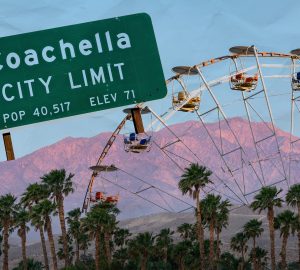Scott Griffin’s exhibition now at Gallery Stokes
By Laura Ann Myers
 Staring into one of Scott Griffin’s Lifescapes is like star-gazing. Each of his pieces is a combination of collage, resin and iridescent paint and pigments that results in a cavernous deep-sea world.
Staring into one of Scott Griffin’s Lifescapes is like star-gazing. Each of his pieces is a combination of collage, resin and iridescent paint and pigments that results in a cavernous deep-sea world.
Their atmospheres are spooky and unsettling, and the figures in these pieces are at first, somehow familiar. However, upon closer inspection, they are abnormal, grotesque and strangely beautiful. His creatures are created from photos of minerals, pig intestines and other natural elements. The eerie life forms are combined in such a way that seems real, maybe as if they are undiscovered sea anemones at the very bottom of the ocean. In each of the forms the viewer will be searching for clues of what the object may be, as if on a treasure hunt. The forms are frozen in layers of resin, captured like a new species in a Mason jar.
The colors of Griffin’s pieces are bright yet soft and create a space so vast that it
is comparable to the sky. The forms seem to speak to each other, much like the stars in the sky, and hold some sort of secret to nature’s DNA. Griffin said “touching on issues from spirituality to reproduction, they [the lifescapes] walk a line between the sublime and the grotesque.”
Certainly the work raised questions about spirituality: how do beings function in relation to the world, what is the purpose of these beings, creation or evolution?
However, reproduction seemed to be a much stronger theme of the work. In nearly every piece chicken skin, plant parts, or some other unrecognizable element is manipulated to resemble female genitalia, male genitalia or both. Griffin also said that these works are a “celebration of life,” and sex and reproduction are undeniably a large part of life and its cycle. The references, though, are almost too abundant and easily read.
Contrasting this element of life with some other might have been more effective, more conceptually contemplative. Death, community and relationship seem to be
almost completely untapped conditions of life in this work. The format of the pieces is traditional squares or rectangles. This defined space combined with the light, color, and quietness in the work is reminiscent of a very old still- life or perhaps even a vanitas painting. The presentation of the forms within this environment is somewhat academic, not quite as celebratory as Griffin described.
While the resin in these pieces obviously functions formally as a way to create depth, the artist claimed that it “also functions conceptually, binding the life forms together in a clear liquid, much like the common binder of life — water.” However, the resin reflects absolutely no motion, and more accurately resembles glass than water.
This still, behind-glass quality of the images contributes to their study-like presentation. Perhaps if the resin had been allowed to ebb and flow off the edges of the piece, or if the surface was not forcibly smooth but rather organic and rippled, the work would seem more alive, more celebratory.Griffin also said that this imagery is an expression of the “living beauty that [he has] found, and [reflects] a universal connectedness.” Here the artist has hit the nail right on the head. What at first looks like a flower is actually a crystallized mineral, a fish is actually a raw chicken wing, and a rock covered in algae is actually a pig’s stomach.
Griffin has truly found the repetition of nature, the organic components of nature and the interconnectedness of life forms. Griffin is like an astrologer, studying the way stars connect to form constellations, and communicating the way the constellations tell the story of life and existence. The artist is studying life through a magnifying glass, stripping it down into bare components, and assembling stories that verify the correlation between nature and living forms, the universe and mankind.



























